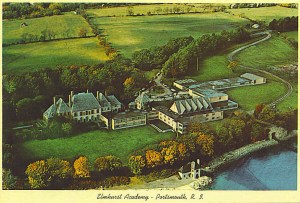 Portsmouth is certainly known for its farms and some of our farms were the best in the state. We have lost many great farms, but this blog will remind us of two very special agricultural businesses: H.C. Anthony Seed Farm and Hathaway Orchards.
Portsmouth is certainly known for its farms and some of our farms were the best in the state. We have lost many great farms, but this blog will remind us of two very special agricultural businesses: H.C. Anthony Seed Farm and Hathaway Orchards.
Henry Clay Anthony grew up on his father’s farm and understood farming, but he also had training at Scoffield Commercial College in Providence and that prepared him for business. Early on Anthony became interested in raising seeds to supply to the local farmers and he perfected his techniques through the years. By 1920 he was the largest seed grower in all of New England. His seed was sold through many areas of the United States and Canada. He had more than 800 acres of land in Rhode Island and rented land in Massachusetts to grow his seed. Besides working at his business for sixteen hours a day, Anthony devoted time to community service as a State Representative, Portsmouth Town Councilman and active member of countless religious and social groups.
You can see some of the drawers that stored Anthony Seeds at Denise Wilkey’s Pottery Studio on East Main Road.
Hathaway Orchards began in 1926 when Howard W. Hathaway bought one hundred and thirty (plus) acres of land around where Montaup Country Club is today. The Hathaway fruit packing house is still used by the Portsmouth Public Works Department as a storage location. Another Hathaway Orchard area was located on Middle Road close to where the Escobar Dairy Farm is today. Some “Hilltop” area streets have names that reflect the fruits that were grown there. From 1932 to 1959 Hathaway Orchards produced peaches, apples, pears, currants and gooseberries.
In 1944 Hathaway had the largest peach orchard in the state and produced 2500 bushels. The peach tree rows were over a mile long. The picking season lasted six weeks. Fifty workers were needed and boys and girls earned two or three dollars a day for their work.
The Hurricane of 1938 severely injured the orchard and it took six years for another good crop to appear. Hurricane Carol in 1953 was the end of the peach orchards, but the apple orchards hung on until 1959. The peach orchard was close to the water and the salt spray from the hurricanes ruined the trees.
Like Henry Anthony, the Hathaways were very involved in the community as well as running their agricultural businesses. Both Howard and Merrill Hathaway (his son) served on the Portsmouth School Committee. Howard also served on the Town Council and as Town Treasurer. Hathaway School is named after Howard Hathaway.
In the Portsmouth Historical Society’s “Lost to Time” exhibit you can see clippings from a Providence Journal article on the Hathaway Orchards and an interview Elmhurst students did with Flo Hathaway Olivieira (Merrill Hathaway’s daughter) about growing up on the orchard. In the display case there are vintage images of Anthony Seed Farm. The Portsmouth Historical Society Museum is open on Sundays from 2PM to 4PM from Memorial Day weekend to Columbus Day weekend.


